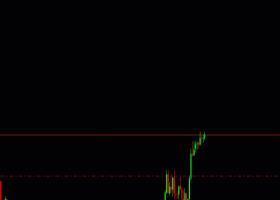Indicators
When I started to trade Forex, I was very interested in indicators. I thought that there definitely are some magic indicators, that will help me to become a millionaire fast. I started to use them without understanding what they mean. Later I started to understand that there’s something wrong. So I analyzed what indicators are. And this are my thoughts about indicators.
1. In Forex we have only one type of information – price. it has volume, but it’s just inside trading volume. It’s very good information, but it doesn’t represent all the markets volume. So all indicators are calculations made with historical prices. No voodoo, no magic here. This means, that don’t matter if your indicators are most complex in the world, they are not able to give you much extra information.
2. There are different types of indicators:
– Strength indicators show what the momentum or movement speed of the price is. Basically these indicators are differences between falling and rising prices. They calculate if there are more rising or falling prices. Most use moving averages. Most popular – RSI, CCI, Stochastic Oscillator, etc. You can detect momentum without any fancy indicators just looking at candles – number of negative and positive, body size and how price moves in short term timeframe. If price starts to raise very fast, 5-10 pips per seconds or so, you may be sure, that momentum is up. Biggest problem of those indicators – they are heavily lagging. If you look at history of CCI for example, it may look useful, but if you try to trade it live, you’ll notice, that it tells you about reversal after candle close and this might be post factum. Looking at price action you might notice reversal sooner.
– Volatility indicators show how price fluctuate during given period. Basically it shows how many times price has changed during given period of time. There are some more complex indicators, that do some calculations, but idea is the same. The best way to watch volatility is to sit by a chart and look how price changes – you will see if market is volatile or calm. If you cannot watch market for a long time, these indicators might be useful. Most popular – ATR (Average True Range), Volatility Chaikin’s, etc.
– Bands indicators also show how price fluctuate during given period of time. In most cases the purpose of bands is to provide a relative definition of high and low. By definition, prices are high at the upper band and low at the lower band. Bands are useful to watch a channel, or to alert when a market is showing low volatility. But low volatility can be spotted with naked eye. Most common bands are Bollinger Bands (BB), Trading Bands (Envelope), etc.
– Trend indicators attempt to show the direction of the trend. These indicators are simple, like moving averages (MA) and main purpose of these indicators is to smooth fluctuations, so it would be easier for a trader to identify market direction. Moving averages are most used indicators. Most other indicators are calculated using moving averages. Well known trading setup – cross of slow MA (like 100 period) by a fast MA (5-20 periods). Problems of these indicators – extremely lagging, they still do not tell the trend direction and strength, trader has to decide by himself. There are „cool“ trend indicators that puts arrows on a chart. These arrows should tell when a trend reverses. And they tell … But there’s a problem – they disappear and appear as the market moves, so if a trader takes a trade after arrow appears and market doesn’t reverse – arrow will disappear. The problem is that trade will not disappear. Good trend indicators – Forecast Oscillator, Linear regression, MACD, Moving Average, Parabolic SAR.
– Volume indicators should tell how much money buys or sells selected currency pair. As I mentioned provides volume numbers, but they do not represent whole market. And as Forex is not centralized market, we cannot get correct volume values. So to talk about volume indicators in Forex is useless. Most common indicators – Chaikin Money Flow, Demand Index, On Balance Volume (OBV), etc.
3. I think that indicators cannot be as a trading strategy alone. Indicators can only help to see a better picture of the market. And in most cases they are just confusing trader and providing the same information that is already on a candle chart, just in more complex way. If you use indicators – use simple ones.
4. In my opinion best trader tools are lines drawn by hand. By lines I mean supports and resistances, channels. Another great tool is Fibonacci. But a trader has to understand that Fibonacci is not magic – it just shows how many percent prices has moved from high towards previous low or vice versa. And there’s a chance that for example in the middle of the move (50% Fibonacci retracement) price will change it’s direction, or if breaks it will reach next Fibonacci level.
5. At the beginning of my Forex journey I’ve tested many indicators manually and programmatically. And I couldn’t find a reliable one. Now there is only one indicator – Moving Average on my charts. And I use it not as a trend indicator, but as support or resistance. In my opinion all fancy, magic and complex indicators are just disturbance.
6. Instead of all these indicators I would suggest to use a little bit of fundamentals. By fundamentals I mean not just economic news, but also timing (during different hours market behaves differently), sentiment (which is hard to find out, but possible) and similar.
7. In conclusion – do not think that lot’s of indicators on charts will help to become profitable. There is no Holy Grail – only hard work, discipline and experience. And nor voodoo, nor magic, nor stars will help you.
Risk, money management
Most of us started to trade Forex because of leverage. At the start it looked like it’s possible to earn 100% of your deposit per day. We started trading with full leverage and with big or no Stop Loss (SL), in most cases. It is possible to be profitable many times in a row. But when you have no SL only one bad trade means a margin call. If SL is high – one bad trade can kill all your profit trades. So what should we do? These are by thoughts:
1. Always use SL and do not increase it – only reducing, moving to BE or trailing stop is acceptable.
2. Always calculate risk/reward. Depending on your strategy risk/reward should be positive. It means, that if you lose – you lose less pips when you win. If you choose trades like this it will be enough to have 50% profitable trades and you still will be positive in a long term. This should be a part of your strategy.
3. Longer term or swing traders should use from 1/4 to 1/2 risk/reward. Scalpers can use 1/1. Some scalpers use negative, but then it’s hard to be profitable in a long term. Only if scalping strategy has a solid report with 80%-90% profitable trades negative (2/1 or so) risk/reward can be used.
4. In my belief no more than 3% of equity can be risked on one trade. Same currency pair and same direction trades, opened at the same time shouldn’t exceed 3% in total risk too. Some traders like to decompose one trade into three, and they calculate pips in sum of all these trades, but average should be counted. This is cheating on yourself.
5. To reduce unexpected risks like technical problems, slippage, psychological aspects (greed, panic, wish to win back, etc), mistakes in strategy it’s advisable to open 5 to 10 or even more accounts and spread the equity. And one day trade only one account with full or half leverage. If account doubles or rises 50% – remove the money and put into new account or withdraw and spend. In this case margin call will be available on only one of many accounts. For example if trader has $1000 to trade, he should have 5 accounts $200 each and risk no more than $30 on each trade.
6. And again – never ever remove or increase SL – this leads to disaster.



